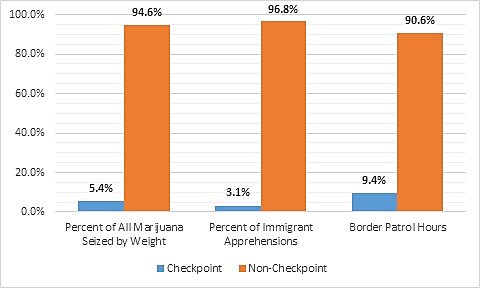Data from a new Government Accountability Office (GAO) report shows that interior checkpoints manned by Border Patrol agents are a poor use of resources, at least from an enforcement perspective. Border Patrol checkpoints would have to have apprehended about 100,000 to 120,000 more illegal immigrants from FY2013-2016 than they actually did to justify the man-hours spent occupying them by agents. Even those who support expanding immigration enforcement along the border should recognize that checkpoints are a waste of scarce border security resources.
Border Patrol agents man checkpoints within 100 miles of the U.S. border where they can stop motorists, inquire about immigration status, and enforce other laws. Checkpoints are a significant risk to civil liberties and are expensive to run. Supporters argue that checkpoints are effective at enforcing federal laws against illegal immigration and drugs, although Border Patrol officials state that they are more concerned about the former. However, the number of illegal immigrant apprehensions, drug seizures by weight, and the deployment of Border Patrol man-hours to checkpoints show that they are not a good use of resources if the goal is to enforce immigration and drug laws.
Figure 1 comes from data reported by the GAO for FY2013-2016. About 9.4 percent of all man-hours worked by Border Patrol were at checkpoints but they only apprehended 3.1 percent of all illegal immigrants apprehended and 5.4 percent of all marijuana seized by weight, at best. At worst, Border Patrol apprehended only 1.9 percent of all illegal immigrants at checkpoints (this same number estimate is not reported for marijuana seizures). This means that Border Patrol agents would have to have apprehended 101,219 to 120,978 more illegal immigrants from FY2013-2016 at checkpoints than they actually did in order for their expenditure of man-hours to be proportional to their apprehensions.
Border Patrol would have had to seize about 410,952 more pounds of marijuana at checkpoints from FY2013-2016 for their man-hours expenditure there to be proportional to the amount of the drug that they seized. Each unit of time that a Border Patrol agent spends at checkpoints results in fewer apprehensions and marijuana seizures than the same unit of time does spend enforcing those laws outside of checkpoints.
Figure 1
Border Patrol Man-Hours, Marijuana Seized by Weight, and Immigrant Apprehensions by Location, FY2013-2016
Source: Author’s Calculations from GAO.
The allocation of Border Patrol man-hours and the percent of illegal immigrant apprehensions by location comes from pages 29 and 41, respectively, of the GAO report. The marijuana seizures by weight come from page 81, where I multiplied the number of seizures by the maximum possible weight in each category, standardizing for ounces. For the category of marijuana seizures that weighed 250 pounds or more, I assumed that the average seizure was 500 pounds. Marijuana seizures by Border Patrol that weighed 250 pounds or more were only about 1.8 percent of seizures and only 3.7 percent of them occurred at checkpoints so any error from my over-or-underestimation of 500 pounds doesn’t much change the result.
Defenders of checkpoints could argue that they deter illegal immigration, so the best measurement of their effectiveness is not necessarily the number that they do actually apprehend at checkpoints. By occupying checkpoints, Border Patrol agents could divert illegal immigrants and drugs into the hands of Border Patrol agents occupying other non-checkpoint locations. Thus, checkpoints wouldn’t get the apprehension or seizure credit even though they would deserve much of it. Those are defensible theoretical arguments but they lack evidentiary support. Border Patrol should provide that support to justify its seemingly wasteful deployment of agents to checkpoints.
A simple comparative static analysis of man-hours spent on Border Patrol checkpoints shows that they result in apprehending far fewer illegal immigrants and seize less marijuana, per man-hour, than Border Patrol manpower deployed elsewhere. The government needs to make a reasonable case for why this seemingly inefficient allocation of Border Patrol resources to checkpoints is wise. If they cannot do that then they should shut down the checkpoints and stop harassing motorists.

